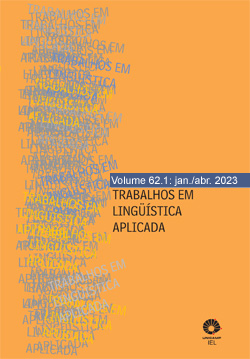Abstract
In this article, we seek to reflect on the interfaces between games and the teaching of writing, through the development and application of a didactic material inspired by the logic of games, which we call the gamer route. The material created is titled “Lara Croft in the temples of Cambodia”, named after the Tomb Raider franchise games. In the game it is possible to assume the identity of a fictional archaeologist. We envision in these games the possibility of exploring literacies and scientific and science popularization genres. The theories of literacies, gamification and Game-Based Learning support the creation of this new model of didactic material. For the application in the classroom, we used the action research methodology and the following data generation instruments: questionnaire, video recording of classes, computer image capture, research diary and interviews. As a main result, we conclude that the gamer route offers students the possibility of experiencing a profession and writing texts in different genres from the assumption of a discursive ethos previously delimited by the character, which allows mobilizing social practice in textual production and understanding in greater depth the scene of enunciation, due to the immersion in the narrative proposal.
References
ARAUJO, W. S. (2014). A construção de identidades: da leitura para o roteiro e do roteiro para a leitura - um estudo analítico de projetos de adaptação de textos literários para jogos digitais. Tese de Doutorado em Língua Portuguesa. Pontifícia Universidade Católica de São Paulo, São Paulo. Disponível em: https://sapientia.pucsp.br/handle/handle/14322. Acesso em: 14 jun. 2022.
BAKHTIN, M. M. (1979). Os gêneros do discurso. In: BAKHTIN, M. M. Estética da criação verbal. Tradução de Paulo Bezerra. 4ª ed. São Paulo, SP: Martins Fontes, 2003, p. 261-306.
BOGOST, I. (2011). Gamification is bullshit! My position statement at the Wharton Gamification Symposium. Ian Bogost Blog. Disponível em: http://bogost.com/writing/blog/gamification_is_bullshit/. Acesso em: 14 jun. 2022.
BURKE, B. (2014). Gamificar: como a gamificação motiva as pessoas a fazerem coisas extraordinárias. Tradução de Sieben Gruppe. São Paulo: DVS Editora, 2015.
BURNS, A. (2010). Doing action research in English language teaching: A guide for practitioners. New York: Routledge.
CHOU, Y. K. (2014). Actionable gamification: beyond points, badges, and leaderboards. San Francisco: Octalysis Media.
DE FREITAS, S. (2006). Learning in immersive worlds: A review of game-based learning. JISC e-Learning Programme, v. 3, p 1-73. Disponível em: https://researchrepository.murdoch.edu.au/id/eprint/35774/1/gamingreport_v3.pdf. Acesso em: 14 jun. 2022.
GEE, J. P. (2003). What video games have to teach us about learning and literacy. New York: Palgrave Macmillan, 2014. [e-book].
GEE, J. P. (2007). Pleasure, learning, video games, and life: The projective stance. In: KNOBEL, M.; L., Colin (orgs.). A new literacies sampler. New York: Peter Lang.
KAPP, K. M. (2012). The gamification of learning and instruction: game-based methods and strategies for training and education. San Francisco: Pfeiffer.
KLEIMAN, A. B. (2006). Leitura e prática social no desenvolvimento de competências no ensino médio. In: BUNZEN, C.; MENDONÇA, M. (Orgs.). Português no ensino médio e formação do professor. São Paulo: Parábola Editorial, 2006, p. 23-36.
MAINGUENEAU, D. (2005). Ethos, cenografia, incorporação. In: AMOSSY, R. (org.) Imagens de si no discurso: a construção do ethos. 2ª ed. Tradução de Dilson Ferreira da Cruz, Fabiana Komesu e Sírio Possenti. São Paulo: Contexto, 2019.
MAINGUENEAU, D. (2008). A propósito do ethos. In: MOTTA, A. R.; SALGADO, L. (orgs.). Ethos discursivo. Tradução de Luciana Salgado. São Paulo: Contexto, p. 11-29.
MAINGUENEAU, D. (2010). Doze conceitos em análise do discurso. Tradução de Adail Sobral et al. São Paulo: Parábola Editorial, 2010.
NOFFKE, S.; SOMEKH, B. (2005). Action Research. In: SOMEKH, B.; LEWIN, C. (orgs.). Research methods in social sciences. London: Sage Publications, p. 89-96.
OLIVEIRA, M. D. B. G. de et al. (2013). Arqueologia estratégica: abordagens para o estudo da totalidade e construção de sítios monticulares. Boletim do Museu Paraense Emílio Goeldi. Ciências Humanas, v. 8, n. 3, p. 517-533. Disponível em: https://www.redalyc.org/pdf/3940/394035001003.pdf. Acesso em: 14 jun. 2022.
SANTAELLA, L. (2007). Linguagens líquidas na era da mobilidade. São Paulo: Paulus.
SCHNEUWLY, B.; DOLZ, J. (1997). Os gêneros escolares – das práticas de linguagem aos objetivos de ensino. Tradução de Glaís Sales Cordeiro. Revista Brasileira de Educação, n. 11, p. 5-16, 2004.
SCHOBER, J. (2003). Metodologia depende do objeto de estudo. ComCiência, 10 set. 2003. Disponível em: http://www.comciencia.br/dossies-1-72/reportagens/arqueologia/arq07.shtml. Acesso em: 14 jun. 2022.
STREET, B. V. (1995). Letramentos sociais: abordagens críticas do letramento no desenvolvimento, na etnografia e na educação. Tradução de Marcos Bagno. São Paulo: Parábola Editorial, 2014.

This work is licensed under a Creative Commons Attribution 4.0 International License.
Copyright (c) 2023 Trabalhos em Linguística Aplicada


